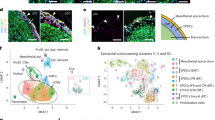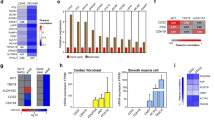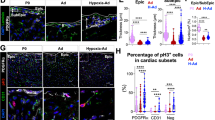Abstract
The epicardium supports cardiomyocyte proliferation early in development and provides fibroblasts and vascular smooth muscle cells to the developing heart. The epicardium has been shown to play an important role during tissue remodeling after cardiac injury, making access to this cell lineage necessary for the study of regenerative medicine. Here we describe the generation of epicardial lineage cells from human pluripotent stem cells by stage-specific activation of the BMP and WNT signaling pathways. These cells display morphological characteristics and express markers of the epicardial lineage, including the transcription factors WT1 and TBX18 and the retinoic acid–producing enzyme ALDH1A2. When induced to undergo epithelial-to-mesenchymal transition, the cells give rise to populations that display characteristics of the fibroblast and vascular smooth muscle lineages. These findings identify BMP and WNT as key regulators of the epicardial lineage in vitro and provide a model for investigating epicardial function in human development and disease.
This is a preview of subscription content, access via your institution
Access options
Subscribe to this journal
Receive 12 print issues and online access
$209.00 per year
only $17.42 per issue
Buy this article
- Purchase on Springer Link
- Instant access to full article PDF
Prices may be subject to local taxes which are calculated during checkout







Similar content being viewed by others
References
DeRuiter, M.C., Poelmann, R.E., VanderPlas-de Vries, I., Mentink, M.M. & Gittenberger-de Groot, A.C. The development of the myocardium and endocardium in mouse embryos. Fusion of two heart tubes? Anat. Embryol. (Berl.) 185, 461–473 (1992).
Limana, F., Capogrossi, M.C. & Germani, A. The epicardium in cardiac repair: from the stem cell view. Pharmacol. Ther. 129, 82–96 (2011).
Komiyama, M., Ito, K. & Shimada, Y. Origin and development of the epicardium in the mouse embryo. Anat. Embryol. (Berl.) 176, 183–189 (1987).
Austin, A.F., Compton, L.A., Love, J.D., Brown, C.B. & Barnett, J.V. Primary and immortalized mouse epicardial cells undergo differentiation in response to TGFbeta. Dev. Dyn. 237, 366–376 (2008).
Bax, N.A. et al. In vitro epithelial-to-mesenchymal transformation in human adult epicardial cells is regulated by TGFbeta-signaling and WT1. Basic Res. Cardiol. 106, 829–847 (2011).
von Gise, A. et al. WT1 regulates epicardial epithelial to mesenchymal transition through beta-catenin and retinoic acid signaling pathways. Dev. Biol. 356, 421–431 (2011).
Morabito, C.J., Dettman, R.W., Kattan, J., Collier, J.M. & Bristow, J. Positive and negative regulation of epicardial-mesenchymal transformation during avian heart development. Dev. Biol. 234, 204–215 (2001).
Smith, C.L., Baek, S.T., Sung, C.Y. & Tallquist, M.D. Epicardial-derived cell epithelial-to-mesenchymal transition and fate specification require PDGF receptor signaling. Circ. Res. 108, e15–e26 (2011).
Lie-Venema, H. et al. Origin, fate, and function of epicardium-derived cells (EPDCs) in normal and abnormal cardiac development. ScientificWorldJournal 7, 1777–1798 (2007).
Christoffels, V. Regenerative medicine: muscle for a damaged heart. Nature 474, 585–586 (2011).
Moore, A.W., McInnes, L., Kreidberg, J., Hastie, N.D. & Schedl, A. YAC complementation shows a requirement for Wt1 in the development of epicardium, adrenal gland and throughout nephrogenesis. Development 126, 1845–1857 (1999).
Haenig, B. & Kispert, A. Analysis of TBX18 expression in chick embryos. Dev. Genes Evol. 214, 407–411 (2004).
Moss, J.B. et al. Dynamic patterns of retinoic acid synthesis and response in the developing mammalian heart. Dev. Biol. 199, 55–71 (1998).
Xavier-Neto, J., Shapiro, M.D., Houghton, L. & Rosenthal, N. Sequential programs of retinoic acid synthesis in the myocardial and epicardial layers of the developing avian heart. Dev. Biol. 219, 129–141 (2000).
Huang, G.N. et al. C/EBP transcription factors mediate epicardial activation during heart development and injury. Science 338, 1599–1603 (2012).
Lepilina, A. et al. A dynamic epicardial injury response supports progenitor cell activity during zebrafish heart regeneration. Cell 127, 607–619 (2006).
Cai, C.L. et al. A myocardial lineage derives from Tbx18 epicardial cells. Nature 454, 104–108 (2008).
Zhou, B. et al. Epicardial progenitors contribute to the cardiomyocyte lineage in the developing heart. Nature 454, 109–113 (2008).
Smart, N. et al. De novo cardiomyocytes from within the activated adult heart after injury. Nature 474, 640–644 (2011).
van Tuyn, J. et al. Epicardial cells of human adults can undergo an epithelial-to-mesenchymal transition and obtain characteristics of smooth muscle cells in vitro. Stem Cells 25, 271–278 (2007).
Kattman, S.J. et al. Stage-specific optimization of activin/nodal and BMP signaling promotes cardiac differentiation of mouse and human pluripotent stem cell lines. Cell Stem Cell 8, 228–240 (2011).
Klaus, A., Saga, Y., Taketo, M.M., Tzahor, E. & Birchmeier, W. Distinct roles of Wnt/beta-catenin and Bmp signaling during early cardiogenesis. Proc. Natl. Acad. Sci. USA 104, 18531–18536 (2007).
Watt, A.J., Battle, M.A., Li, J. & Duncan, S.A. GATA4 is essential for formation of the proepicardium and regulates cardiogenesis. Proc. Natl. Acad. Sci. USA 101, 12573–12578 (2004).
MacNeill, C., French, R., Evans, T., Wessels, A. & Burch, J.B. Modular regulation of cGATA-5 gene expression in the developing heart and gut. Dev. Biol. 217, 62–76 (2000).
Ma, Q., Zhou, B. & Pu, W.T. Reassessment of Isl1 and Nkx2–5 cardiac fate maps using a Gata4-based reporter of Cre activity. Dev. Biol. 323, 98–104 (2008).
Liu, J. & Stainier, D.Y. Tbx5 and Bmp signaling are essential for proepicardium specification in zebrafish. Circ. Res. 106, 1818–1828 (2010).
Bochmann, L. et al. Revealing new mouse epicardial cell markers through transcriptomics. PLoS ONE 5, e11429 (2010).
Mahtab, E.A. et al. Cardiac malformations and myocardial abnormalities in podoplanin knockout mouse embryos: correlation with abnormal epicardial development. Dev. Dyn. 237, 847–857 (2008).
Dubois, N.C. et al. SIRPA is a specific cell-surface marker for isolating cardiomyocytes derived from human pluripotent stem cells. Nat. Biotechnol. 29, 1011–1018 (2011).
Mellgren, A.M. et al. Platelet-derived growth factor receptor beta signaling is required for efficient epicardial cell migration and development of two distinct coronary vascular smooth muscle cell populations. Circ. Res. 103, 1393–1401 (2008).
Phillips, M.D., Mukhopadhyay, M., Poscablo, C. & Westphal, H. Dkk1 and Dkk2 regulate epicardial specification during mouse heart development. Int. J. Cardiol. 150, 186–192 (2011).
Yu, P.B. et al. Dorsomorphin inhibits BMP signals required for embryogenesis and iron metabolism. Nat. Chem. Biol. 4, 33–41 (2008).
Kruithof, B.P. et al. BMP and FGF regulate the differentiation of multipotential pericardial mesoderm into the myocardial or epicardial lineage. Dev. Biol. 295, 507–522 (2006).
Casanova, J.C., Travisano, S. & de la Pompa, J.L. Epithelial-to-mesenchymal transition in epicardium is independent of Snail1. Genesis 51, 32–40 (2013).
Cheung, C., Bernardo, A.S., Trotter, M.W., Pedersen, R.A. & Sinha, S. Generation of human vascular smooth muscle subtypes provides insight into embryological origin-dependent disease susceptibility. Nat. Biotechnol. 30, 165–173 (2012).
Acharya, A. et al. The bHLH transcription factor Tcf21 is required for lineage-specific EMT of cardiac fibroblast progenitors. Development 139, 2139–2149 (2012).
El-Mounayri, O. et al. Serum-free differentiation of functional human coronary-like vascular smooth muscle cells from embryonic stem cells. Cardiovasc. Res. 98, 125–135 (2013).
Yang, L. et al. Human cardiovascular progenitor cells develop from a KDR+ embryonic-stem-cell-derived population. Nature 453, 524–528 (2008).
Lian, X. et al. Robust cardiomyocyte differentiation from human pluripotent stem cells via temporal modulation of canonical Wnt signaling. Proc. Natl. Acad. Sci. USA 109, E1848–E1857 (2012).
Ueno, S. et al. Biphasic role for Wnt/beta-catenin signaling in cardiac specification in zebrafish and embryonic stem cells. Proc. Natl. Acad. Sci. USA 104, 9685–9690 (2007).
David, R. et al. MesP1 drives vertebrate cardiovascular differentiation through Dkk-1-mediated blockade of Wnt-signalling. Nat. Cell Biol. 10, 338–345 (2008).
Weeke-Klimp, A. et al. Epicardium-derived cells enhance proliferation, cellular maturation and alignment of cardiomyocytes. J. Mol. Cell. Cardiol. 49, 606–616 (2010).
Gaudesius, G., Miragoli, M., Thomas, S.P. & Rohr, S. Coupling of cardiac electrical activity over extended distances by fibroblasts of cardiac origin. Circ. Res. 93, 421–428 (2003).
de la Cuesta, F. et al. Deregulation of smooth muscle cell cytoskeleton within the human atherosclerotic coronary media layer. J. Proteomics 82, 155–165 (2013).
Jonasson, L., Holm, J., Skalli, O., Bondjers, G. & Hansson, G.K. Regional accumulations of T cells, macrophages, and smooth muscle cells in the human atherosclerotic plaque. Arteriosclerosis 6, 131–138 (1986).
Winter, E.M. et al. Preservation of left ventricular function and attenuation of remodeling after transplantation of human epicardium-derived cells into the infarcted mouse heart. Circulation 116, 917–927 (2007).
Winter, E.M. et al. A new direction for cardiac regeneration therapy: application of synergistically acting epicardium-derived cells and cardiomyocyte progenitor cells. Circ Heart Fail 2, 643–653 (2009).
Kennedy, M., D'Souza, S.L., Lynch-Kattman, M., Schwantz, S. & Keller, G. Development of the hemangioblast defines the onset of hematopoiesis in human ES cell differentiation cultures. Blood 109, 2679–2687 (2007).
Clarke, R.L. et al. The expression of Sox17 identifies and regulates haemogenic endothelium. Nat. Cell Biol. 15, 502–510 (2013).
Acknowledgements
We thank T. Araki and B. Neel (Ontario Cancer Institute, Toronto) for providing the Sendai hiPSC line, O. El-Mounayri and M. Husain for their advice on epithelial-to-mesenchymal transition, Mark Gagliardi for his assistance in the culture of hESC-derived epicardial cells and the Sick Kids/UHN Flow Cytometry Facility for their assistance with cell sorting. We thank members of the Keller laboratory for their advice on the studies and comments on the manuscript. This work was supported by the Canadian Institute of Health Research (MOP-84524; MOP-119507; MOP-106538; CPG-127793), the Natural Sciences and Engineering Research Council of Canada (CHRPJ 446379-13) and the US National Institutes of Health (5U01 HL100405). This work was funded in part by VistaGen Therapeutics, Inc.
Author information
Authors and Affiliations
Contributions
A.D.W. contributed to designing the study, designing and performing experiments, analyzing the data, and writing and editing the manuscript. A.M. contributed to designing, performing and analyzing experiments concerning calcium imaging, and editing the manuscript. R.Y.T. contributed to designing, performing and analyzing experiments concerning Matrigel invasion. S.A.F. contributed to designing, performing and analyzing experiments concerning Matrigel invasion. A.M. contributed data acquisition concerning cell quantification and editing the manuscript. M.S.S. contributed to designing experiments concerning Matrigel invasion. R.-K.L. contributed to designing experiments concerning calcium imaging. S.J.K. contributed to designing the study and editing the manuscript. G.K. contributed to designing the study, writing and editing the manuscript.
Corresponding author
Ethics declarations
Competing interests
G.K. is on the scientific advisory board and a shareholder of VistaGen Therapeutics, which partially funded this work. A.D.W., S.J.K. and G.K. are co-inventors on a patent application covering the generation of human pluripotent stem cell--derived epicardial cells described here.
Supplementary information
Supplementary Text and Figures
Supplementary Figures 1–7 and Supplementary Table 1 (PDF 39006 kb)
Supplementary Video 1
Representative video depicts Fluo 4-AM-generated fluorescence signal on D8 after EMT initiation during the 12-min recording at 30x speed. (MOV 6280 kb)
Rights and permissions
About this article
Cite this article
Witty, A., Mihic, A., Tam, R. et al. Generation of the epicardial lineage from human pluripotent stem cells. Nat Biotechnol 32, 1026–1035 (2014). https://doi.org/10.1038/nbt.3002
Received:
Accepted:
Published:
Issue Date:
DOI: https://doi.org/10.1038/nbt.3002
This article is cited by
-
Human multilineage pro-epicardium/foregut organoids support the development of an epicardium/myocardium organoid
Nature Communications (2022)
-
CDH18 is a fetal epicardial biomarker regulating differentiation towards vascular smooth muscle cells
npj Regenerative Medicine (2022)
-
Cardiac cell type-specific responses to injury and contributions to heart regeneration
Cell Regeneration (2021)
-
Self-assembling human heart organoids for the modeling of cardiac development and congenital heart disease
Nature Communications (2021)
-
Human iPS-derived pre-epicardial cells direct cardiomyocyte aggregation expansion and organization in vitro
Nature Communications (2021)



